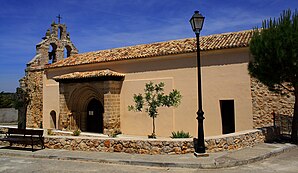Escopete
| Escopete municipality | ||
|---|---|---|
 Escopete - Iglesia de Nuestra Señora de la Asunción
|
||
| coat of arms | Map of Spain | |
 Help on coat of arms |
|
|
| Basic data | ||
| Autonomous Community : | Castile-La Mancha | |
| Province : | Guadalajara | |
| Comarca : | La Alcarria | |
| Coordinates | 40 ° 25 ′ N , 3 ° 0 ′ W | |
| Height : | 835 msnm | |
| Area : | 19.01 km² | |
| Residents : | 57 (Jan. 1, 2019) | |
| Population density : | 3 inhabitants / km² | |
| Postal code : | 19112 | |
| Municipality number ( INE ): | 19112 | |
| administration | ||
| Website : | Escopete | |
Escopete is a central Spanish town and municipality ( municipio ) with only 57 inhabitants (as of January 1, 2019) in the province of Guadalajara in the autonomous region of Castile-La Mancha . The municipality belongs to the sparsely populated region of the Serranía Celtibérica .
Location and climate
The approximately 835 m perched village Escopete located in the center of the landscape of Alcarria about 300 meters north of a river bend of the Tagus to the north of the southern part of the Iberian plateau ( meseta ) . Guadalajara , the provincial capital, is a good 47 km (driving distance) to the northwest; the lovely town of Pastrana is only about 10 km to the east. The climate in winter is temperate, while in summer it is warm to hot; the rather low amounts of precipitation (approx. 455 mm / year) fall - with the exception of the almost rainless summer months - distributed over the whole year.
Population development
| year | 1857 | 1900 | 1950 | 2000 | 2019 |
| Residents | 295 | 332 | 390 | 60 | 57 |
As a result of the mechanization of agriculture , the abandonment of small farms and the resulting loss of jobs, the population of the municipality has decreased significantly since the middle of the 20th century ( rural exodus ).
economy
The people of earlier centuries lived mainly as self-sufficiency from agriculture and livestock farming , whose durable products (cheese, sausage, animal skins and wool) could be exchanged or sold at traveling traders.
history
The Celts , Romans , Visigoths and even the Moors left no usable traces on the municipality. In the second half of the 11th century the latter were by the army of King Alfonso VI. driven out of the region by León ( reconquista ) , who gave the area to the Order of Calatrava ; then began the phase of repopulation ( repoblación ) by Christians from many parts of the Iberian Peninsula . A written mention of the place name from the High Middle Ages is not known and so it is assumed that it originated in the 14th / 15th centuries. Century from. In 1541, Doña Ana de la Cerda, the grandmother of the Princess of Eboli († 1592) acquired the place and its surroundings; these remained under the manorial rule (señorio) of the Duchy of El Infantado and thus of the House of Mendoza until the beginning of the 19th century.
Attractions
The small late Romanesque Iglesia de Nuestra Señora de la Asunción is dedicated to the Assumption of Mary and has a three-arched bell gable (espadaña) above the unadorned west facade. The step portal , which clearly protrudes from the surrounding wall and is protected by a small canopy, is located on the south side of the church; the outer arch shows a diamond rod . The nave is not vaulted, but is spanned by an open roof structure . The church was damaged during the Spanish Civil War (1936-1939).
literature
- Yolanda Navarro: Escopete, un siglo en la memoria . Editores del Henares 2009, ISBN 978-84-61386-39-0 .
Web links
- Escopete - Photo + Info (Spanish)
Individual evidence
- ↑ Cifras oficiales de población resultantes de la revisión del Padrón municipal a 1 de enero . Population statistics from the Instituto Nacional de Estadística (population update).
- ↑ Escopete / Pastrana - climate tables
- ↑ Escopete - population development
- ↑ Escopete History

